A Novel Power Flow Algorithm for Traction Power Supply Systems Based on the Thévenin Equivalent
Abstract
:1. Introduction
- The Thévenin equivalent of a TPSS feeding section is introduced, which concentrates efforts on train nodes instead of all nodes. Fewer variables need consideration than in the previous algorithms. It can help with not only power flow analysis, but also the TPSS harmonic impedance calculation in resonance analysis.
- Node voltage equations are converted into port characteristic equations according to the Thévenin equivalent. The Newton-Raphson method is exploited to solve those equations, which has faster convergence than the MNFA. Besides, it has an easier approach to multiple solutions than the CPF.
- The RPF based on the PA is utilized to calculate the PSC of a typical China high-speed railway TPSS. Some practical recommendations are proposed to optimize the organization of train operations. The minimum intervals of adjacent trains are estimated.
2. Algorithm Description
2.1. Thévenin Equivalent of Feeding Section
- Identification of Ei
- Set all train currents to 0 A.
- Solve node voltage equations.
- Ei equals the voltage of train i.
- Identification of Zik
- Set the current supplied by the substation to 0 A.
- Set the current of train k to −1 A, and that of the others to 0 A.
- Solve node voltage equations.
- Zik equals the voltage of train i.
2.2. Port Characteristic Equations Solving
- Set the initial value of the train current vectorAlternatively, set the initial values of the train voltages first, and then calculate the train currents.
- Calculate the residual vectorwhere
- Calculate the Jacobian matrixwhereThis step will not take much time since most elements are constant.
- Solve the corrective equationto obtain the corrective vector ∆I.J∆I = b
- If the norm of ∆I is smaller than a given value e, finish the calculation successfully. Otherwise, subtract ∆I from I and go to Step 6.
- If the number of iterations reaches a given value N, finish the calculation unsuccessfully. Otherwise, go to Step 2.
3. Numerical Results
3.1. Test System
3.2. Algorithm Properties
3.2.1. Convergence Speed
3.2.2. Ability to Find Multiple Solutions
4. Application to PSC Calculation
4.1. RPF Procedure
- Set the complex power of each train to 0.
- Choose a load change pattern and step length, namely how much the complex power of each train increases or decreases.
- Increase the power according to the chosen pattern and step length.
- Perform the PA. If the calculation converges, go to Step 3. Otherwise, go to Step 5.
- If the step length is smaller than a given value ε, finish the calculation. Otherwise, go to Step 6.
- Decrease the step length, for instance, by half.
- Decrease the power according to the pattern and new step length, and go to Step 4.
4.2. Case Studies
4.2.1. Case 1
4.2.2. Case 2
4.2.3. Discussion
5. Conclusions
Acknowledgments
Author Contributions
Conflicts of Interest
References
- Gómez-Expósito, A.; Mauricio, J.M.; Maza-Ortega, J.M. VSC-based MVDC railway electrification system. IEEE Trans. Power Deliv. 2014, 29, 422–431. [Google Scholar] [CrossRef]
- Östlund, S. Rail power supplies going more power electronic. IEEE Electr. Mag. 2014, 2, 4–60. [Google Scholar] [CrossRef]
- Raygani, S.V.; Tahavorgar, A.; Fazel, S.S.; Moaveni, B. Load flow analysis and future development study for an AC electric railway. IET Electr. Syst. Transp. 2012, 2, 139–147. [Google Scholar] [CrossRef]
- Song, K.J.; Wu, M.L.; Agelidis, V.G.; Wang, H. Line current harmonics of three-level neutral-point-clamped electric multiple unit rectifiers: Analysis, simulation and testing. IET Power Electron. 2014, 7, 1850–1858. [Google Scholar]
- Zhao, N.; Roberts, C.; Hillmansen, S.; Nicholson, G. A multiple train trajectory optimization to minimize energy consumption and delay. IEEE Trans. Intell. Transp. Syst. 2015, 16, 2363–2372. [Google Scholar] [CrossRef]
- Wang, K.; Zhou, F.; Chen, J.Y.; Zhou, G.P. Capacity improvement based on power accommodation STATCOM for traction power supply. Electr. Power Autom. Equip. 2012, 32, 44–49. [Google Scholar]
- Battistelli, L.; Pagano, M.; Proto, D. 2 × 25-kV 50 Hz high-speed traction power system: Short-circuit modeling. IEEE Trans. Power Deliv. 2011, 26, 1459–1466. [Google Scholar] [CrossRef]
- Venikov, V.A.; Stroev, V.A.; Idelchick, V.I.; Tarasov, V.I. Estimation of electrical power system steady-state stability in load flow calculations. IEEE Trans. Power Appar. Syst. 1975, 94, 1034–1041. [Google Scholar] [CrossRef]
- Gravener, M.H.; Nwankpa, C. Available transfer capability and first order sensitivity. IEEE Trans. Power Syst. 1999, 14, 512–518. [Google Scholar] [CrossRef]
- Ou, Y.; Singh, C. Assessment of available transfer capability and margins. IEEE Trans. Power Syst. 2002, 17, 463–468. [Google Scholar] [CrossRef]
- Ou, Y.; Singh, C. Calculation of risk and statistical indices associated with available transfer capability. IEEE Proc. Gener. Transm. Distrib. 2003, 150, 239–244. [Google Scholar] [CrossRef]
- Zhang, S.; Cheng, H.; Zhang, L.; Bazargan, M.; Yao, L. Probabilistic evaluation of available load supply capability for distribution system. IEEE Trans. Power Syst. 2013, 28, 3215–3225. [Google Scholar] [CrossRef]
- Xu, S.; Miao, S. Calculation of TTC for multi-area power systems based on improved Ward-PV equivalents. IET Gener. Transm. Distrib. 2017, 11, 987–994. [Google Scholar] [CrossRef]
- Ho, T.K.; Chi, Y.L.; Wang, J.; Leung, K.K.; Siu, L.K.; Tse, C.T. Probabilistic load flow in AC electrified railways. IEEE Proc. Electr. Power Appl. 2005, 152, 1003–1013. [Google Scholar] [CrossRef] [Green Version]
- Pilo, E.; Rouco, L.; Fernández, A.; Hernández-Velilla, A. A simulation tool for the design of the electrical supply system of high-speed railway lines. In Proceedings of the IEEE 2000 Power Engineering Society Summer Meeting, Seattle, WA, USA, 16–20 July 2000. [Google Scholar]
- Wan, Q.Z.; Wu, M.L.; Chen, J.Y.; Wang, Z.J.; Liu, X.Y. Simulating calculation of traction substation’s feeder current based on traction calculation. Trans. China Electrotech. Soc. 2007, 22, 108–113. [Google Scholar]
- Aodsup, K.; Kulworawanichpong, T. Effect of train headway on voltage collapse in high-speed AC railways. In Proceedings of the Asia-Pacific Power and Energy Engineering Conference (APPEEC), Shanghai, China, 27–29 March 2012. [Google Scholar]
- Hill, R.J.; Cevik, I.H. On-line simulation of voltage regulation in autotransformer-fed AC electric railroad traction networks. IEEE Trans. Veh. Technol. 1993, 42, 365–372. [Google Scholar] [CrossRef]
- Ho, T.K.; Chi, Y.L.; Wang, J.; Leung, K.K. Load flow in electrified railway. In Proceedings of the Second International Conference on Power Electronics, Machines and Drives 2004 (PEMD 2004), Edinburgh, UK, 31 March–2 April 2004. [Google Scholar]
- Hsi, P.; Chen, S.; Li, R. Simulating on-line dynamic voltages of multiple trains under real operating conditions for AC railways. IEEE Trans. Power Syst. 1999, 14, 452–459. [Google Scholar]
- He, Z.Y.; Fang, L.; Guo, D.; Yang, J.W. Algorithm for power flow of electric traction network based on equivalent circuit of AT-fed system. J. Southwest Jiaotong Univ. 2008, 43, 1–7. [Google Scholar]
- Guo, D.; Yang, J.W.; He, Z.Y.; Zhao, J. Research on a flow analysis method of power supply system of AC high speed railway based on Newton method. Relay 2007, 35, 16–20. [Google Scholar]
- Goodman, C.J. Modelling and simulation. In Proceedings of the 4th IET Professional Development Course on Railway Electrification Infrastructure and Systems (REIS 2009), London, UK, 1–5 June 2009. [Google Scholar]
- Wu, M.L. Modelling of AC feeding systems of electric railways based on a uniform multi-conductor chain circuit topology. In Proceedings of the IET Conference on Railway Traction Systems (RTS 2010), Birmingham, UK, 13–15 April 2010. [Google Scholar]
- Wu, M.L. Uniform chain circuit model for traction networks of electric railways. Proc. CSEE 2010, 30, 52–58. [Google Scholar]
- He, J.W.; Li, Q.Z.; Liu, W.; Zhou, X.H. General mathematical model for simulation of AC traction power supply system and its application. Power Syst. Technol. 2010, 34, 25–29. [Google Scholar]
- Chen, H.W.; Geng, G.C.; Jiang, Q.Y. Power flow algorithm for traction power supply system of electric railway based on locomotive and network coupling. Autom. Electr. Power Syst. 2012, 36, 76–80. [Google Scholar]
- Hu, H.T.; He, Z.Y.; Wang, J.F.; Gao, S.B.; Qian, Q.Q. Power flow calculation for high-speed railway traction network based on train-network coupling systems. Proc. CSEE 2012, 32, 101–108. [Google Scholar]
- Zhi, H. Analysis of traction power supply capability for high-speed railway based on test data. High. Speed Railw. Technol. 2013, 4, 28–31. [Google Scholar]
- Wang, B.; Hu, H.T.; Gao, S.B.; Han, X.D.; He, Z.Y. Power flow calculation and analysis for high-speed railway traction network under regenerative braking. China Railw. Sci. 2014, 35, 86–93. [Google Scholar] [CrossRef]
- Ajjarapu, V.; Christy, C. The continuation power flow: A tool for steady state voltage stability analysis. IEEE Trans. Power Syst. 1992, 7, 416–423. [Google Scholar] [CrossRef]
- Iba, K.; Suzuki, H.; Egawa, M.; Watanabe, T. Calculation of critical loading condition with nose curve using homotopy continuation method. IEEE Trans. Power Syst. 1991, 6, 584–593. [Google Scholar] [CrossRef]
- Canizares, C.A.; Alvarado, F.L. Point of collapse and continuation methods for large AC/DC systems. IEEE Trans. Power Syst. 1993, 8, 1–8. [Google Scholar] [CrossRef]
- Chiang, H.; Flueck, A.J.; Shah, K.S.; Balu, N. CPFLOW: A practical tool for tracing power system steady-state stationary behavior due to load and generation variations. IEEE Trans. Power Syst. 1995, 10, 623–634. [Google Scholar] [CrossRef]
- Ejebe, G.C.; Tong, J.; Waight, J.G.; Frame, J.G.; Wang, X.; Tinney, W.F. Available transfer capability calculations. IEEE Trans. Power Syst. 1998, 13, 1521–1527. [Google Scholar] [CrossRef]
- Trias, A. The holomorphic embedding load flow method. In Proceedings of the 2012 IEEE Power and Energy Society General Meeting, San Diego, CA, USA, 22–26 July 2012. [Google Scholar]
- Rao, S.; Feng, Y.; Tylavsky, D.J.; Subramanian, M.K. The holomorphic embedding method applied to the power-flow problem. IEEE Trans. Power Syst. 2016, 31, 3816–3828. [Google Scholar] [CrossRef]
- Liu, C.; Wang, B.; Xu, X.; Sun, K.; Shi, D.; Bak, C.L. A multi-dimensional holomorphic embedding method to solve AC power flows. IEEE Access. 2017, 5, 25270–25285. [Google Scholar] [CrossRef]
- Basiri-Kejani, M.; Gholipour, E. Holomorphic embedding load-flow modeling of thyristor-based FACTS controllers. IEEE Trans. Power Syst. 2017, 32, 4871–4879. [Google Scholar] [CrossRef]
- Wang, B.; Liu, C.; Sun, K. Multi-stage holomorphic embedding method for calculating the power–voltage curve. IEEE Trans. Power Syst. 2018, 33, 1127–1129. [Google Scholar] [CrossRef]
- Ortega, J.M.; Rheinboldt, W.C. Iterative Solution of Nonlinear Equations in Several Variables; Academic Press: New York, NY, USA, 1970. [Google Scholar]
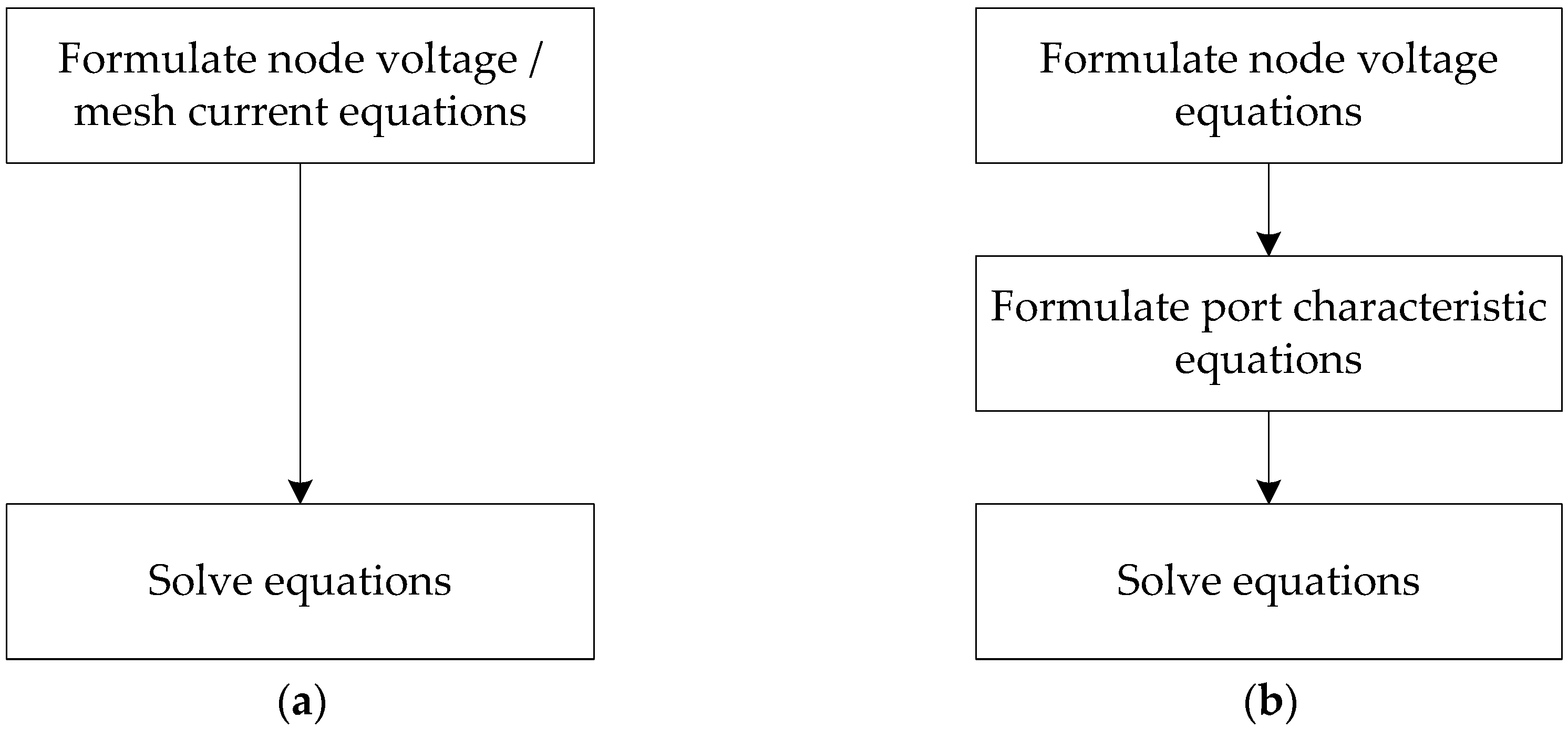
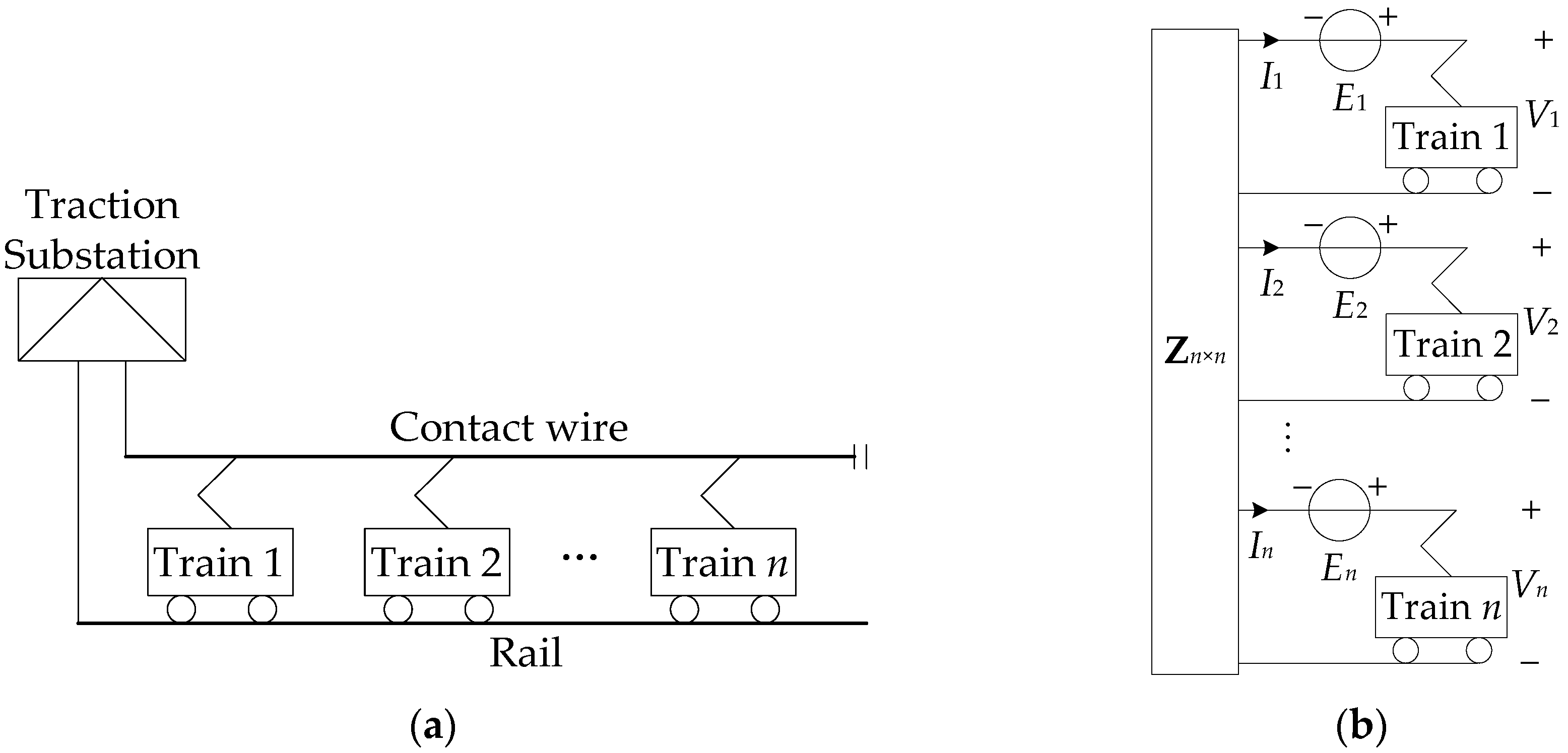
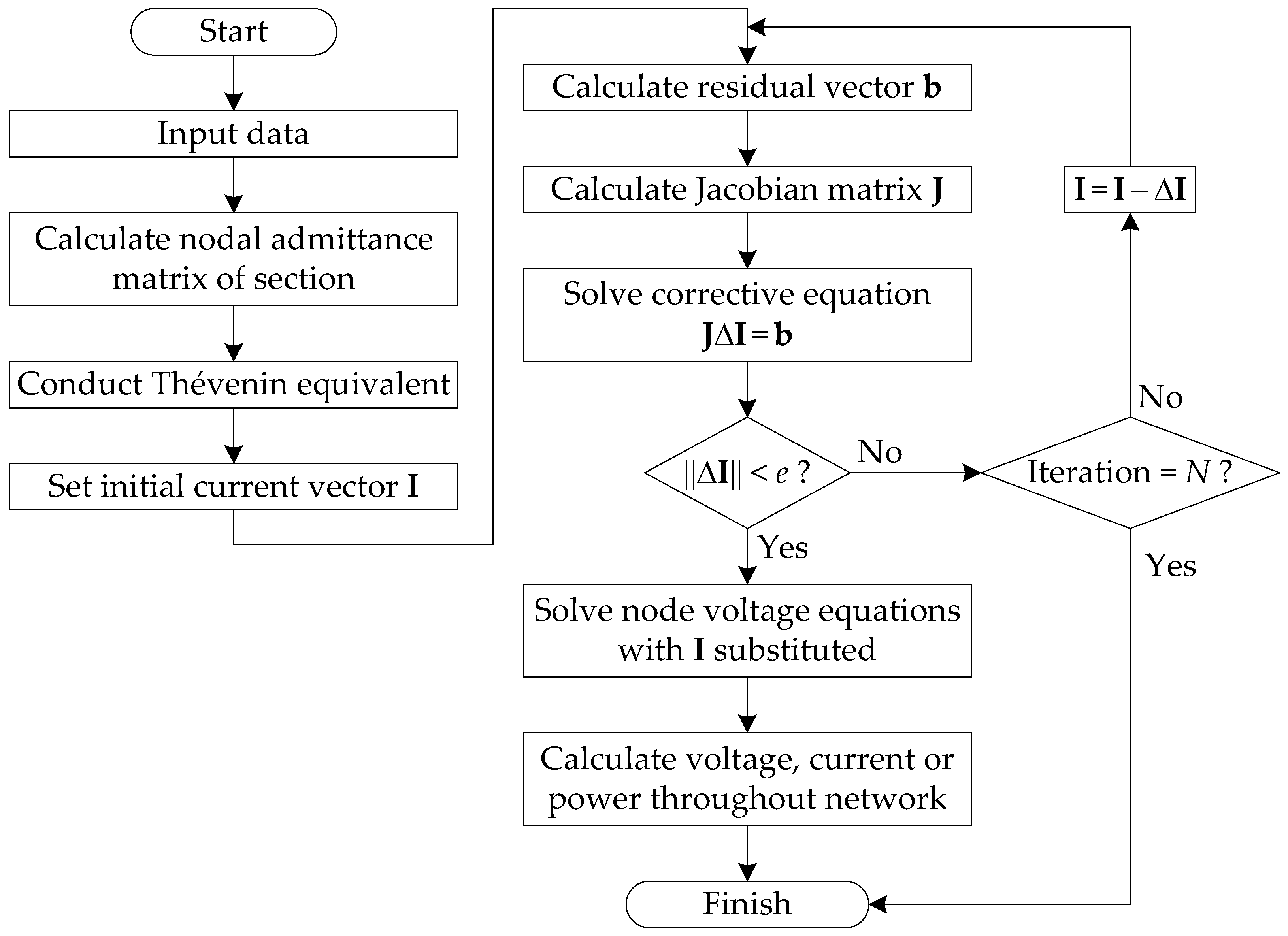
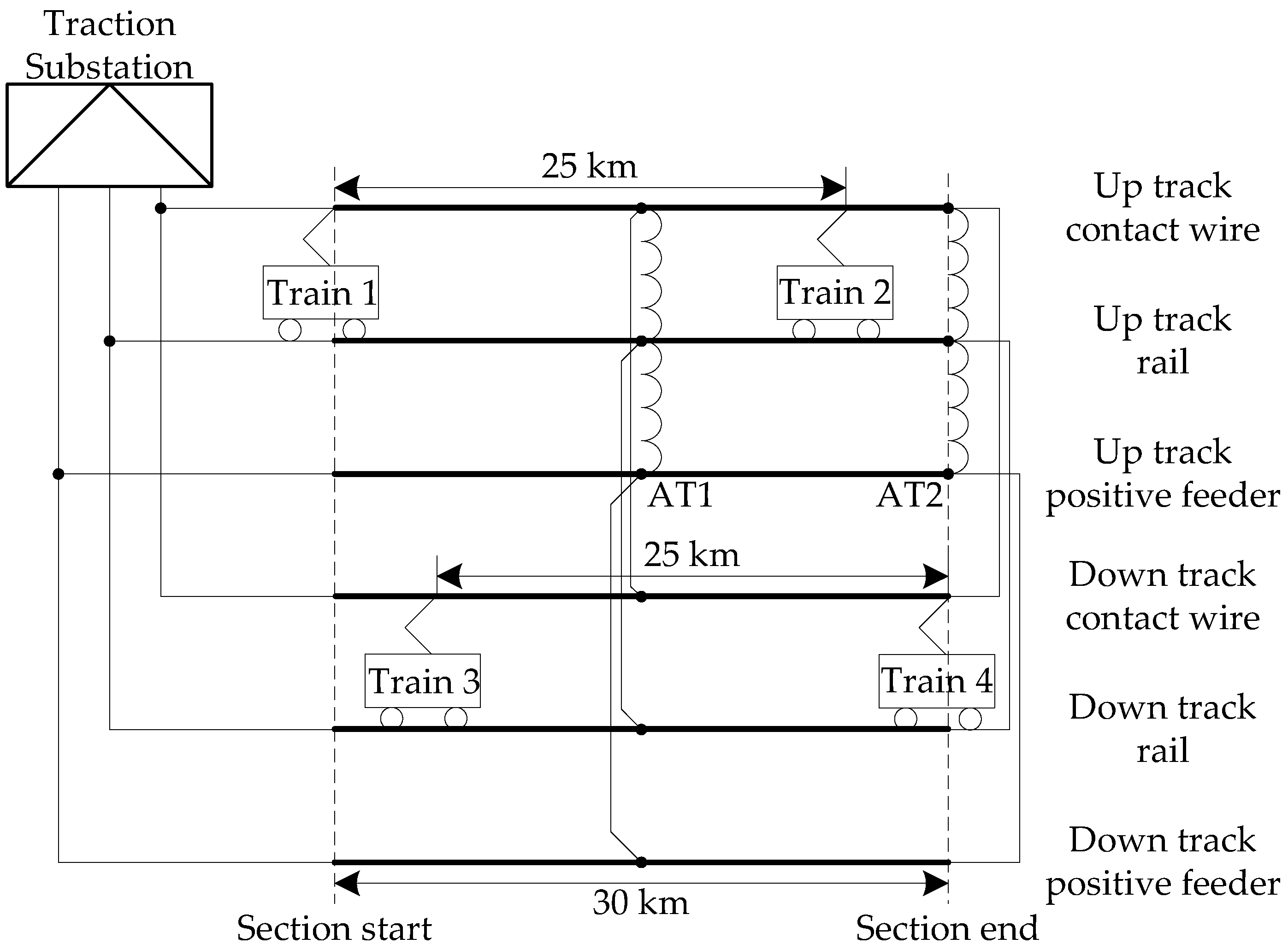

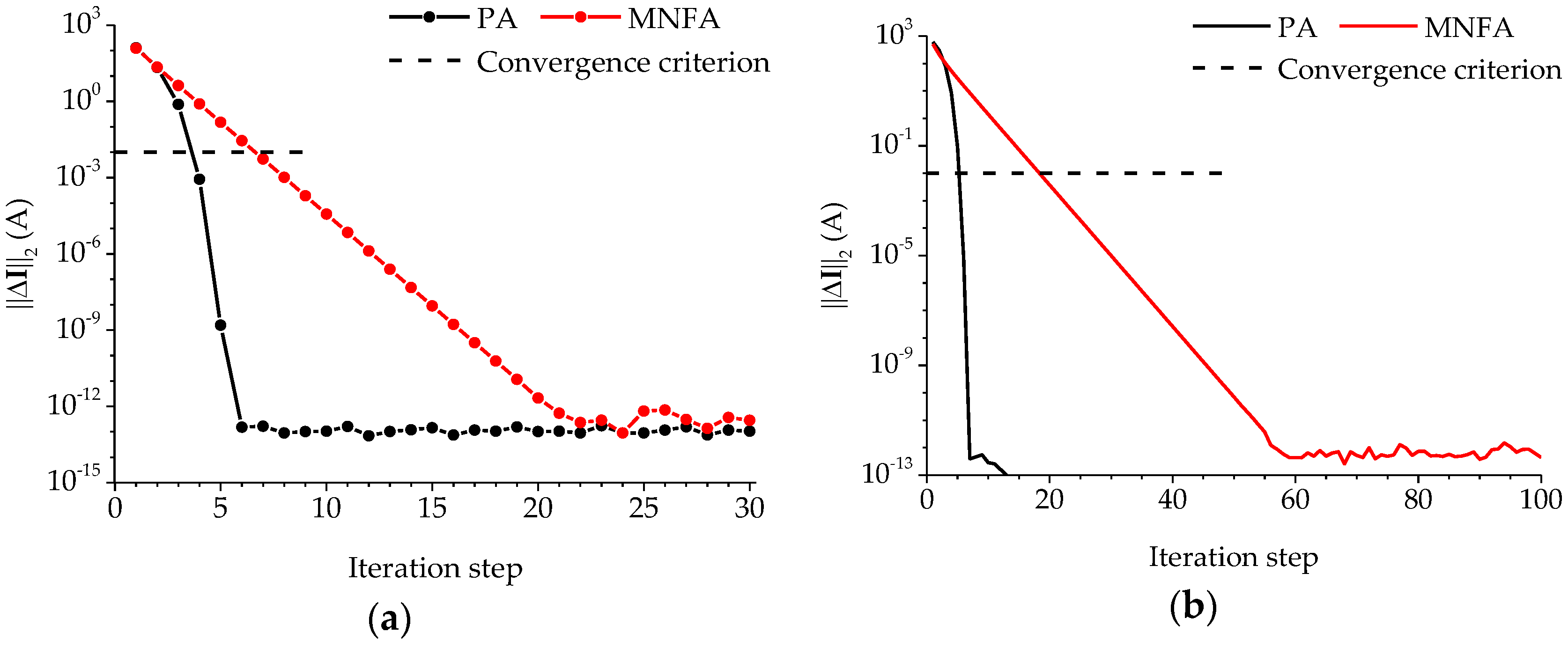
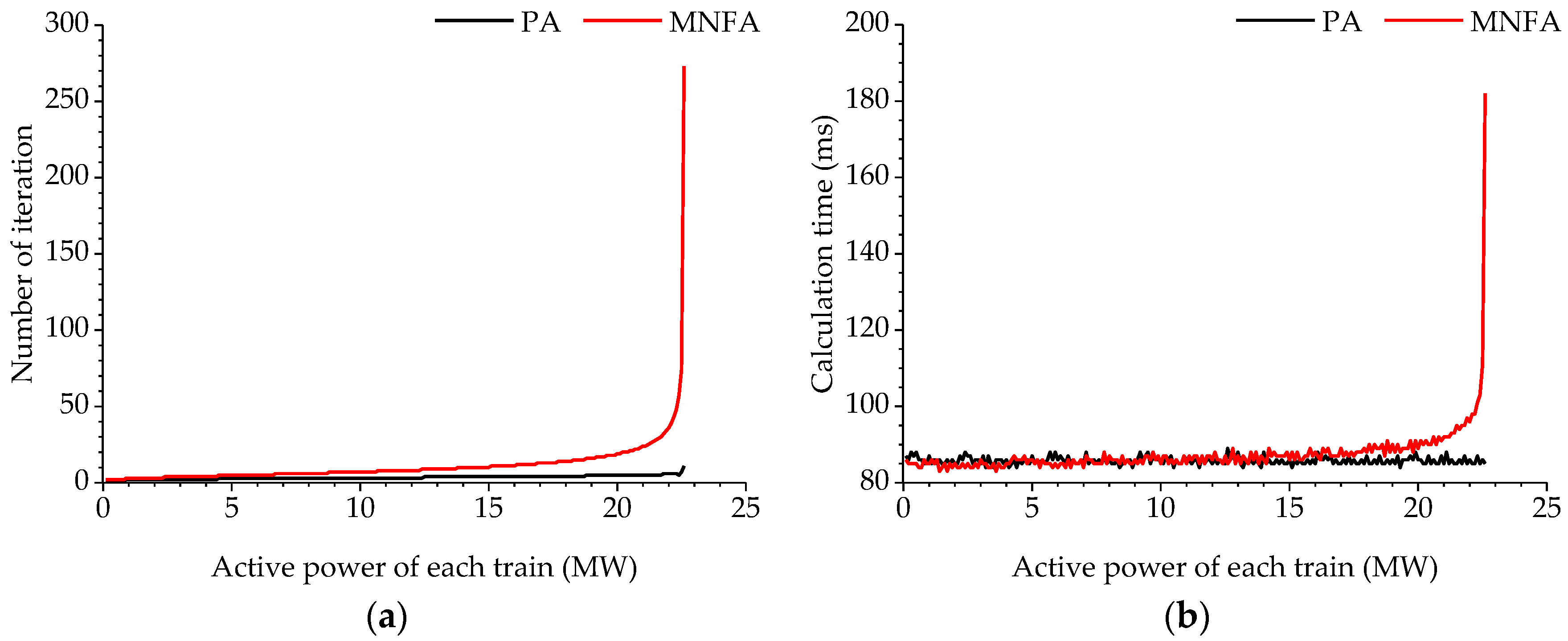
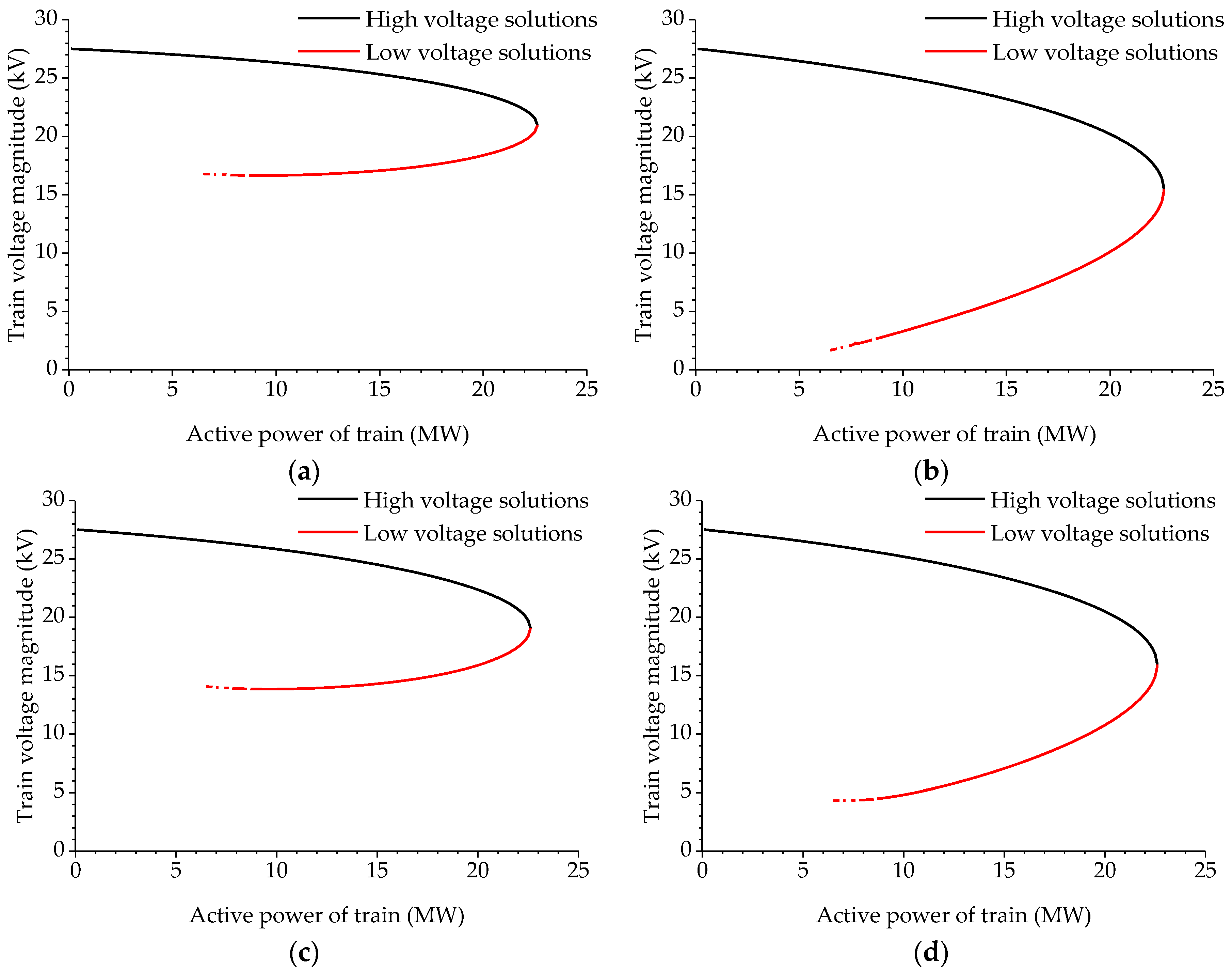
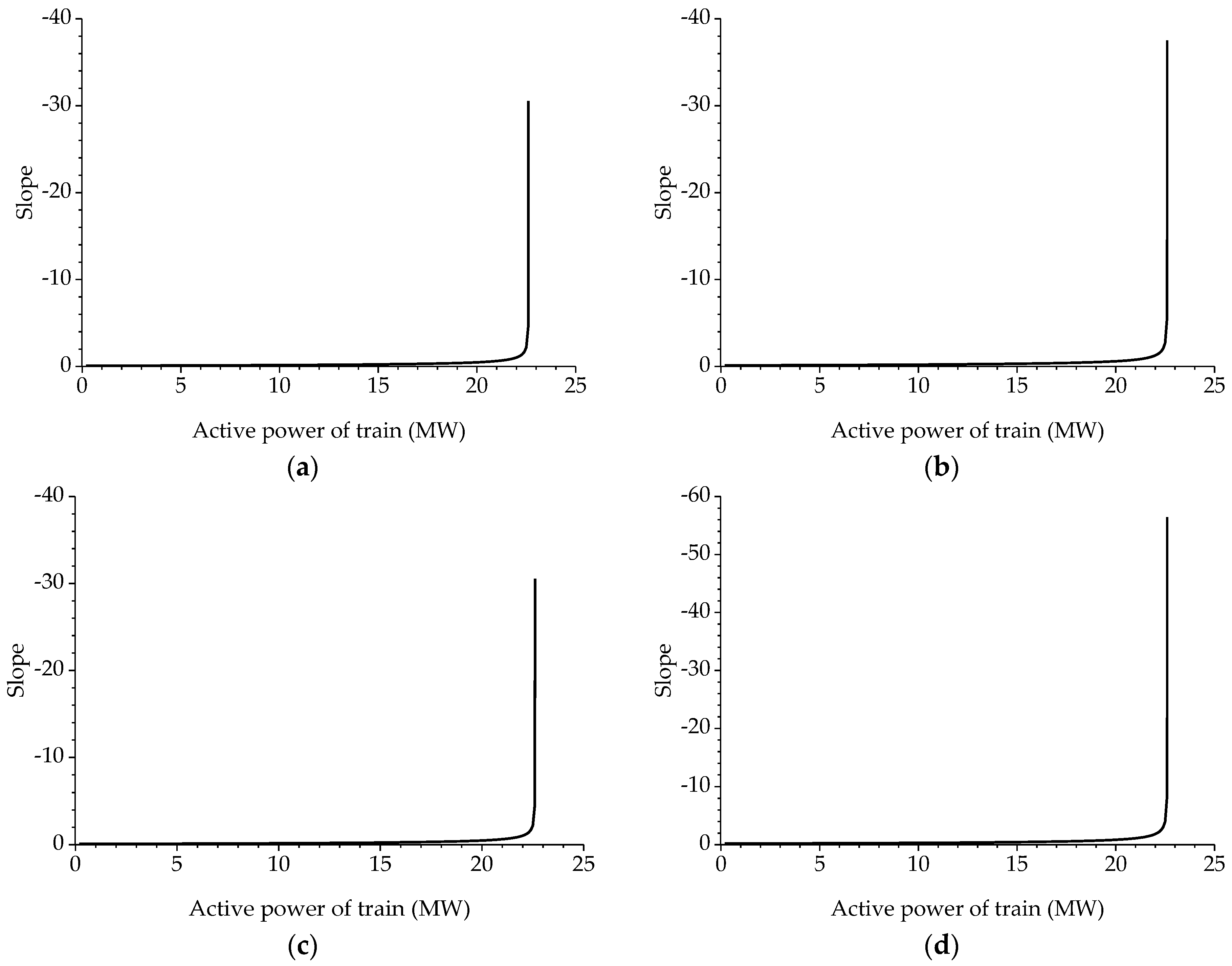
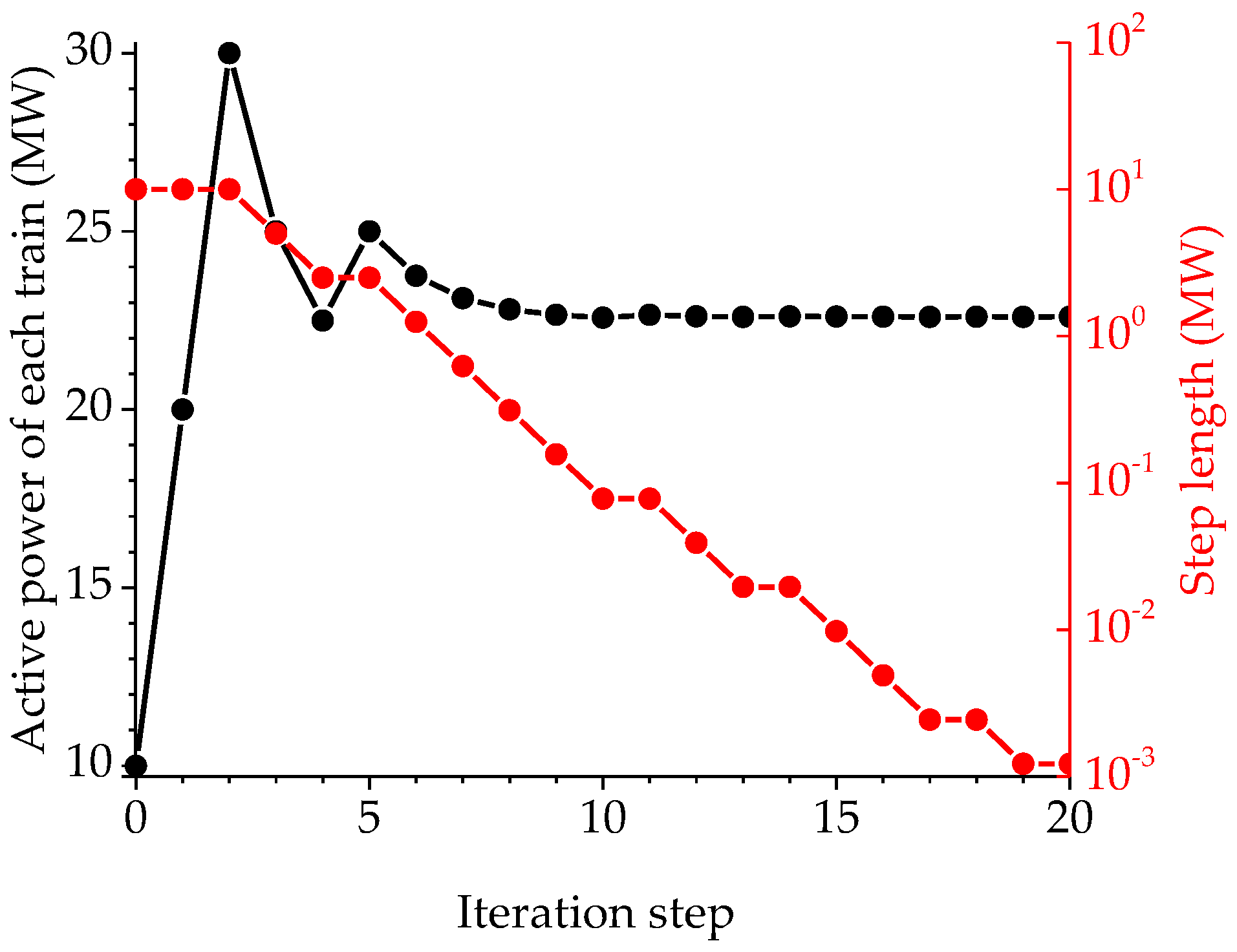

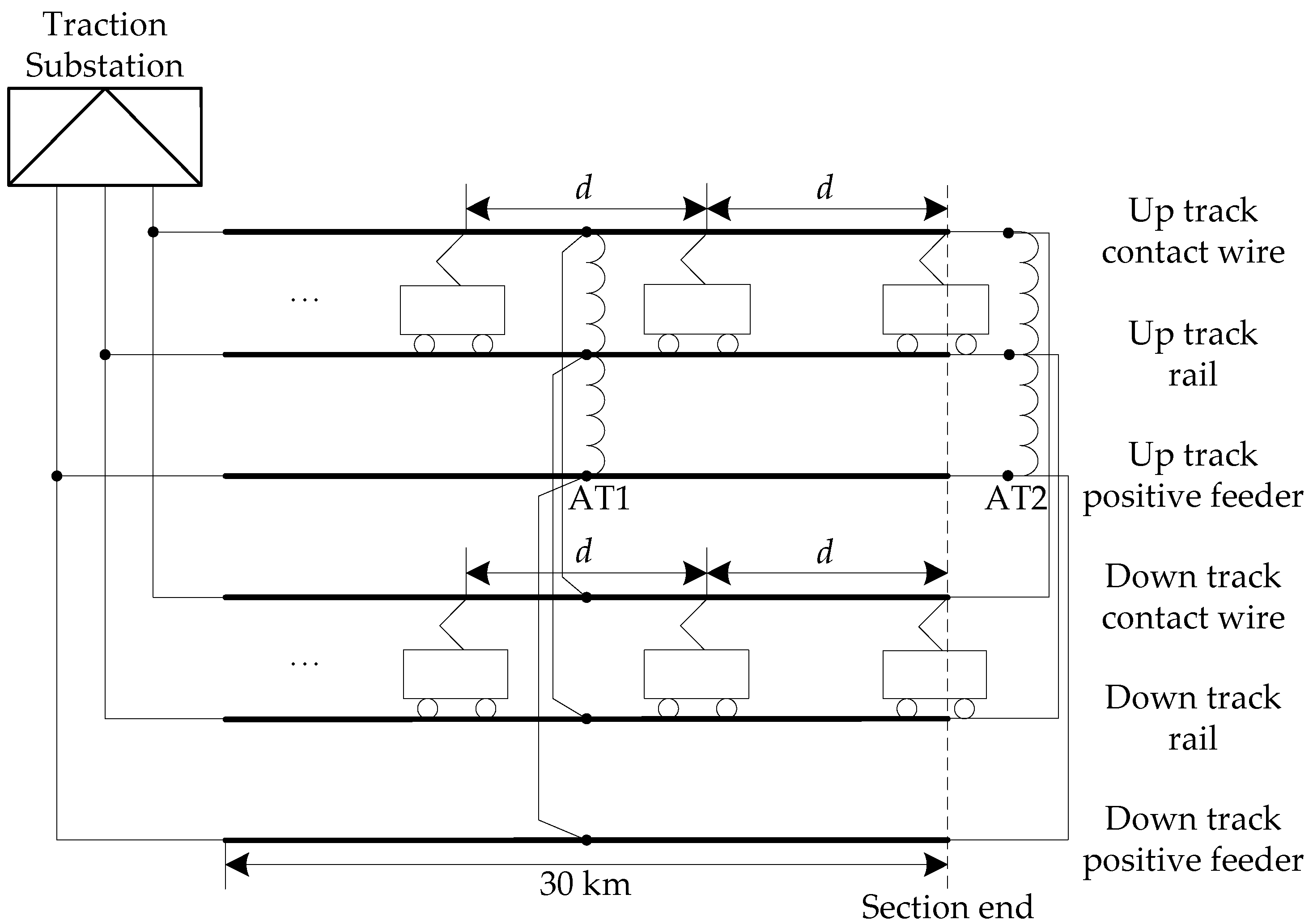

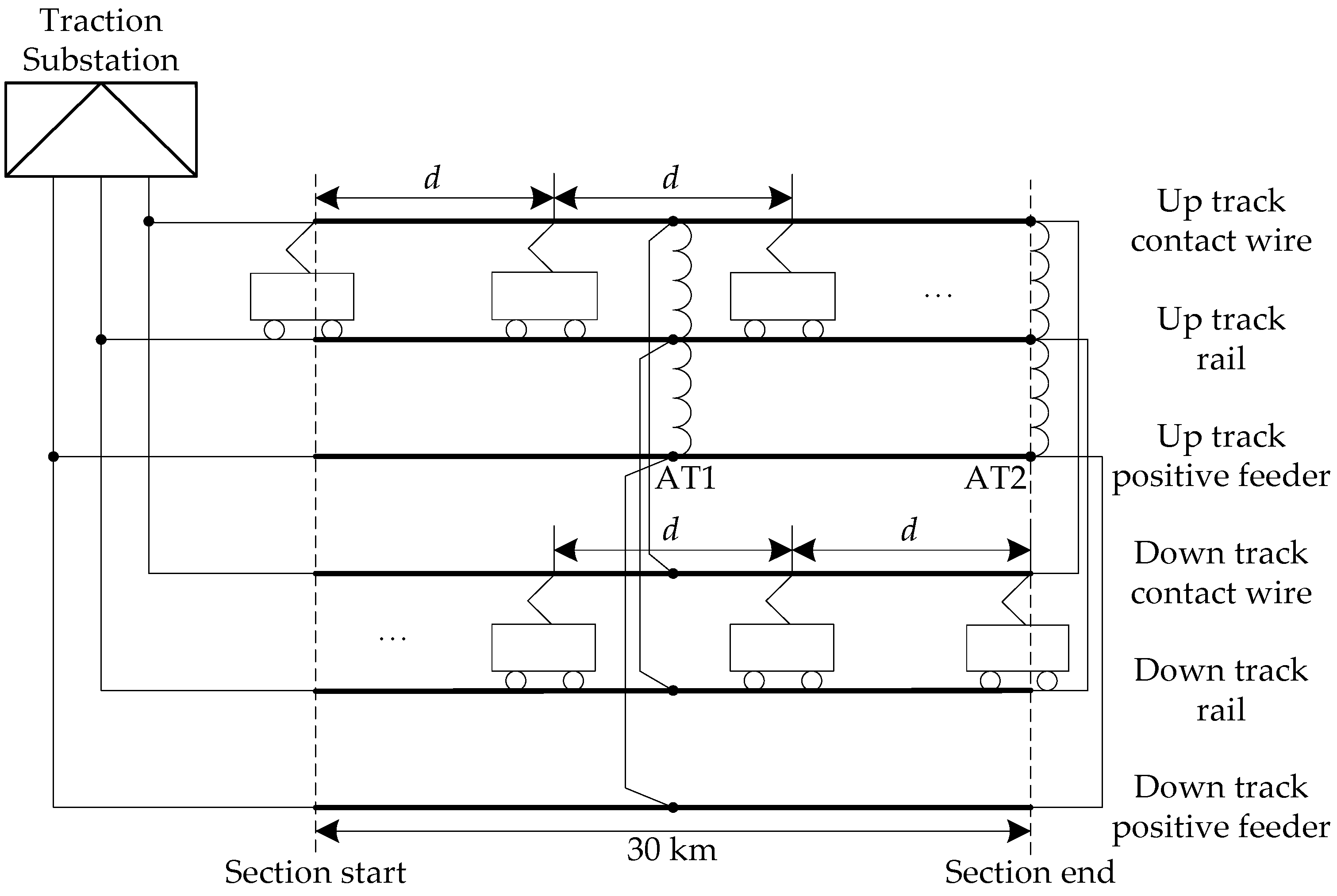
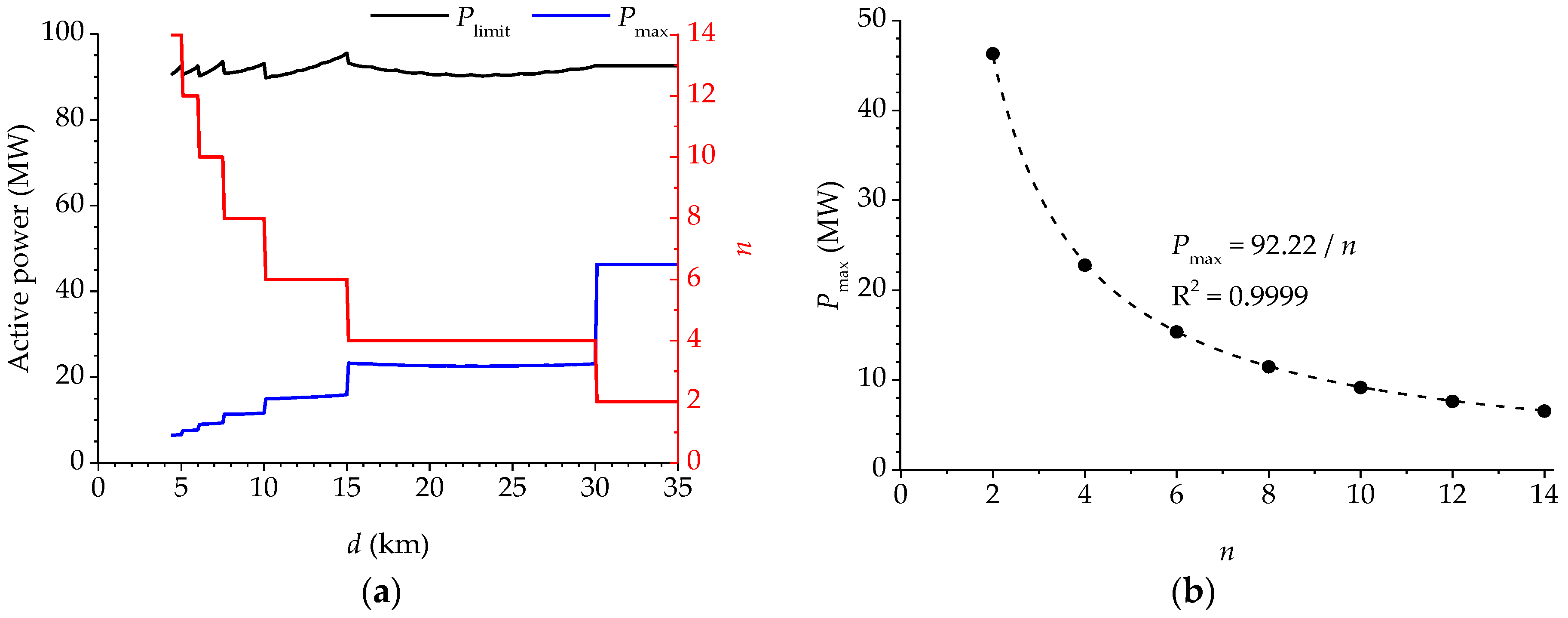
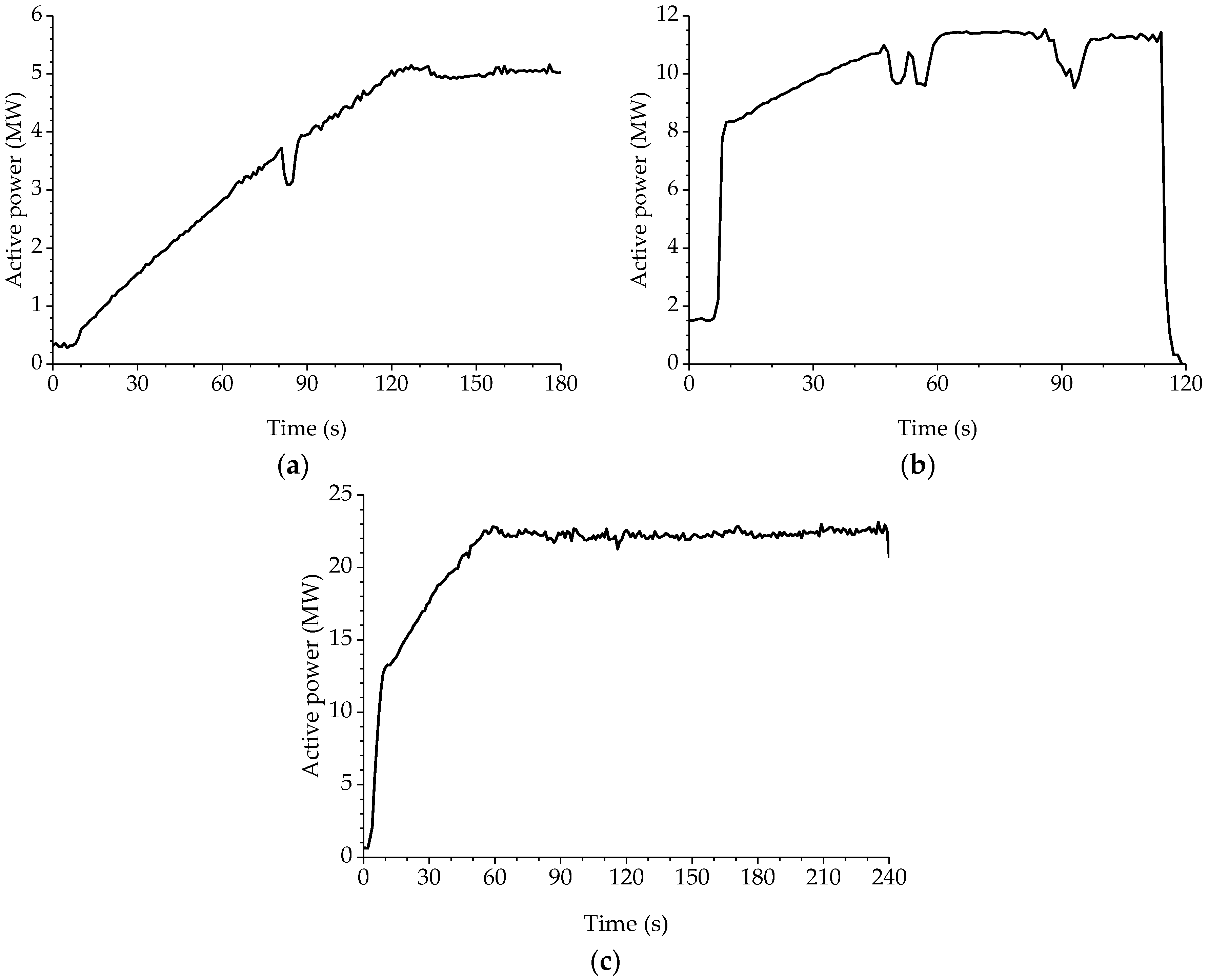
| Algorithm | Model Accuracy | Applicability to Feeding Scheme | Convergence Speed |
|---|---|---|---|
| [14] | Accurate | All | Linear |
| [15,16,17] | Accurate | All | Quadratic |
| [3,18,19,20,21] | Accurate | AT 1 feeding | Linear |
| [22] | Accurate | AT feeding | Quadratic |
| MNFA 2 | More accurate | All | Linear |
| PA | More accurate | All | Quadratic |
| Parameter | Value |
|---|---|
| Section | |
| Track | 2 |
| Length | 30 km |
| Public grid | |
| System capacity | 5000 MVA |
| Voltage | 220 kV |
| Traction transformer | |
| Connection | single phase with secondary mid-point drawn out |
| Rated capacity | 40 MVA |
| Rated voltage | 220 kV/2 × 27.5 kV |
| Impedance | 8.4% |
| AT | |
| Location | 15 km and 30 km away from the substation |
| Leakage impedance | (0.1 + j 0.45) Ω |
| Trains | |
| Locations | as depicted in Figure 4 |
| Active power | the same value for all trains |
| Power factor | 0.97 lagging |
| Conductors | as depicted in Figure 5 |
| Rail to earth resistance | 100 Ωkm |
| Earth resistivity | 100 Ωm |
| Initial values of the train voltages | 40 kV |
| Convergence criterion | ‖∆I‖2 < 0.01 |
| Train | MNFA | PA | Difference |
|---|---|---|---|
| 1 | 26,162.81 − j 3049.25 | 26,162.79 − j 3049.25 | 0.02 |
| 2 | 24,639.93 − j 4664.22 | 24,639.89 − j 4664.22 | 0.04 |
| 3 | 25,585.18 − j 3666.87 | 25,585.15 − j 3666.87 | 0.03 |
| 4 | 24,784.16 − j 4552.74 | 24,784.12 − j 4552.74 | 0.04 |
| Train | MNFA | PA | Difference |
|---|---|---|---|
| 1 | 22,791.54 − j 6299.11 | 22,791.49 − j 6299.12 | 0.05 + j 0.01 |
| 2 | 18,037.97 − j 9100.00 | 18,037.88 − j 9099.99 | 0.09 − j 0.01 |
| 3 | 21,108.93 − j 7411.10 | 21,108.87 − j 7411.10 | 0.06 |
| 4 | 18,459.19 − j 8933.77 | 18,459.10 − j 8933.76 | 0.09 − j 0.01 |
| Train | High Voltage Solutions | Low Voltage Solutions | Difference |
|---|---|---|---|
| 1 | 26,162.79 − j 3049.25 | 15,959.64 − j 4789.04 | 10,203.15 + j 1739.79 |
| 2 | 24,639.89 − j 4664.22 | 1206.80 − j 3075.46 | 23,433.09 − j 1588.76 |
| 3 | 25,585.15 − j 3666.87 | 12,878.89 − j 5093.25 | 12,706.26 + j 1426.38 |
| 4 | 24,784.12 − j 4552.74 | 2848.02 − j 3879.99 | 21,936.10 − j 672.75 |
| Train | High Voltage Solutions | Low Voltage Solutions | Difference |
|---|---|---|---|
| 1 | 22,791.49 − j 6299.12 | 16,952.05 − j 7108.26 | 5839.44 + j 809.14 |
| 2 | 18,037.88 − j 9099.99 | 6071.67 − j 8086.42 | 11,966.21 − j 1013.57 |
| 3 | 21,108.87 − j 7411.10 | 13,760.17 − j 7954.93 | 7348.70 + j 543.83 |
| 4 | 18,459.10 − j 8933.76 | 6989.39 − j 8192.97 | 11,469.71 − j 740.79 |
| Level | Active Power Consumption | Minimum Interval in Case 1 | Minimum Interval in Case 2 |
|---|---|---|---|
| 1 | 5 MW | <5 km/<1 min | <5 km/<1 min |
| 2 | 10 MW | 7.5 km/1.5 min | 7.5 km/1.5 min |
| 3 | 20 MW | 22 km/4.4 min | 15 km/3 min |
© 2018 by the authors. Licensee MDPI, Basel, Switzerland. This article is an open access article distributed under the terms and conditions of the Creative Commons Attribution (CC BY) license (http://creativecommons.org/licenses/by/4.0/).
Share and Cite
Zhang, J.; Wu, M.; Liu, Q. A Novel Power Flow Algorithm for Traction Power Supply Systems Based on the Thévenin Equivalent. Energies 2018, 11, 126. https://doi.org/10.3390/en11010126
Zhang J, Wu M, Liu Q. A Novel Power Flow Algorithm for Traction Power Supply Systems Based on the Thévenin Equivalent. Energies. 2018; 11(1):126. https://doi.org/10.3390/en11010126
Chicago/Turabian StyleZhang, Junqi, Mingli Wu, and Qiujiang Liu. 2018. "A Novel Power Flow Algorithm for Traction Power Supply Systems Based on the Thévenin Equivalent" Energies 11, no. 1: 126. https://doi.org/10.3390/en11010126





